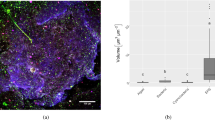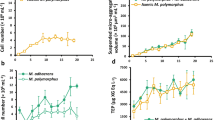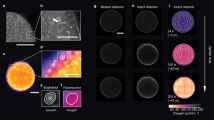Abstract
In aquatic systems, the concept of the ‘microbial loop’ is invoked to describe the conversion of dissolved organic matter to particulate organic matter by bacteria1. This process mediates the transfer of energy and matter from dissolved organic matter to higher trophic levels, and therefore controls (together with primary production) the productivity of aquatic systems. Here we report experiments on laboratory incubations of sterile filtered river water in which we find that up to 25% of the dissolved organic carbon (DOC) aggregates abiotically to particles of diameter 0.4–0.8 micrometres, at rates similar to bacterial growth. Diffusion drives aggregation of low- to high-molecular-mass DOC and further to larger micelle-like microparticles. The chemical composition of these microparticles suggests their potential use as food by planktonic bacterivores. This pathway is apparent from differences in the stable carbon isotope compositions of picoplankton and the microparticles. A large fraction of dissolved organic matter might therefore be channelled through microparticles directly to higher trophic levels—bypassing the microbial loop—suggesting that current concepts of carbon conversion in aquatic systems require revision.
This is a preview of subscription content, access via your institution
Access options
Subscribe to this journal
Receive 51 print issues and online access
$199.00 per year
only $3.90 per issue
Buy this article
- Purchase on Springer Link
- Instant access to full article PDF
Prices may be subject to local taxes which are calculated during checkout




Similar content being viewed by others
References
Azam, F. et al. The ecological role of water column microbes in the sea. Mar. Ecol. Prog. Ser. 10, 257–263 (1983)
Kepkay, P. E. Particle aggregation and the biological reactivity of colloids. Mar. Ecol. Prog. Ser. 109, 293–304 (1994)
Riley, G. A. Organic aggregates in seawater and the dynamics of their formation and utilization. Limnol. Oceanogr. 4, 372–381 (1963)
Hohenberg, H., Mannweiler, K. & Müller, M. High-pressure freezing of cell suspensions in cellulose capillary tubes. J. Microsc. 175, 34–43 (1994)
Ducklow, H. W. & Shia, F.-K. in Aquatic Microbiology (ed. Ford, T. E.) 261–287 (Blackwell, Oxford, 1993)
Chin, W. C., Orellana, M. V. & Verdugo, P. Spontaneous assembly of marine dissolved organic matter into polymer gels. Nature 391, 568–572 (1998)
Leppard, G. G. The characterization of algal and microbial mucilages and their aggregates in aquatic ecosystems. Sci. Tot. Environ. 165, 103–131 (1995)
Hertkorn, N. et al. Comparative analysis of partial structures of a peat humic and fulvic acid using one and two dimensional nuclear magnetic resonance spectroscopy. J. Environ. Qual. 31, 375–387 (2002)
Nanny, M. A. & Maza, J. P. Noncovalent interactions between monoaromatic compounds and dissolved humic acids: a deuterium NMR T1 relaxation study. Environ. Sci. Technol. 35, 379–384 (2001)
Pollard, T. D. & Earnshaw, W. C. Cell Biology 1st edn 277–281 (Elsevier Science, Philadelphia, 2002)
Kerner, M. & Spitzy, A. Nitrate regeneration coupled to degradation of different size fractions of DON by the picoplankton in the Elbe estuary. Microb. Ecol. 41, 69–81 (2001)
Passow, U. & Alldredge, A. L. A dye binding assay for the spectrophotometric measurement of transparent exopolymer particles (TEP). Limnol. Oceanogr. 40, 1326–1335 (1995)
Bianchi, A. & Guiliano, L. Enumeration of viable bacteria in the marine pelagic environment. Appl. Environ. Microbiol. 62, 174–177 (1996)
Fukuda, R., Ogawa, H., Nagata, T. & Koike, J. Direct determination of carbon and nitrogen contents of natural bacterial assemblages in marine environments. Appl. Environ. Microbiol. 65, 3352–3358 (1998)
Posch, T. & Arndt, H. Uptake of sub-micrometre- and micrometre-sized detrital particles by bacterivorous and omnivorous ciliates. Aquat. Microb. Ecol. 10, 45–53 (1996)
Hullar, M., Fry, B., Peterson, B. J. & Wright, R. T. Microbial utilization of estuarine dissolved organic carbon: a stable isotope tracer approach tested by mass balance. Appl. Environ. Microbiol. 62, 2489–2493 (1996)
Nagata, T. & Kirchman, D. L. Roles of submicron particles and colloids in microbial food webs and biogeochemical cycles within marine environments. Adv. Microb. Ecol. 15, 81–103 (1997)
Huber, S. A. & Frimmel, F. H. Flow injection analysis of organic and inorganic carbon in the low-ppb range. Anal. Chem. 63, 2122–2130 (1991)
Raimbault, P. & Slawyk, G. A semiautomatic, wet-oxidation method for the determination of particulate organic nitrogen collected on filters. Limnol. Oceanogr. 36, 405–408 (1991)
Smith, P. K. et al. Measurement of protein using bicinchoninic acid. Anal. Biochem. 150, 76–85 (1985)
Greenspan, P. & Fowler, S. D. Spectrofluorometric studies of the lipid probe, Nile red. J. Lip. Res. 26, 781–789 (1985)
Volke, F. et al. Characterisation of antibiotic moenomycin A interaction with phospholipid model membranes. Chem. Phys. Lipids 85, 115–123 (1997)
Prange, A., Tuempling, W. Jr, Niedergesaess, R. & Jantzen, E. The whole river Elbe in one view: Element distribution of the river Elbe from the spring to the mouth. Wasserw. Wassertechn. 7, 22–31 (1995)
Santschi, P. H. et al. Fibrillar polysaccharides in marine macromolecular organic matter, as imaged by atomic force microscopy and transmission electron microscopy. Limnol. Oceanogr. 43, 896–908 (1998)
Harris, J. R. Negative Staining and Cryoelectron Microscopy: The Thin Film Technique 12–21 (BIOS Scientific Publishers, Oxford, UK, 1997)
Acknowledgements
We thank L. Ehrhardt for technical assistance and H. Lother for discussions. This research was funded by the Deutsche Forschungsgemeinschaft (M.K. and A.S). The Heinrich-Pette-Institute is supported by the Bundesministerium für Gesundheit and the Freie und Hansestadt Hamburg.
Author information
Authors and Affiliations
Corresponding author
Ethics declarations
Competing interests
The authors declare that they have no competing financial interests.
Supplementary information
Rights and permissions
About this article
Cite this article
Kerner, M., Hohenberg, H., Ertl, S. et al. Self-organization of dissolved organic matter to micelle-like microparticles in river water. Nature 422, 150–154 (2003). https://doi.org/10.1038/nature01469
Received:
Accepted:
Issue Date:
DOI: https://doi.org/10.1038/nature01469
This article is cited by
-
Tracing carbon and nitrogen microbial assimilation in suspended particles in freshwaters
Biogeochemistry (2023)
-
Interactions of Ag nanoparticles with humic acid present in surface water
Applied Water Science (2022)
-
Fermentative Spirochaetes mediate necromass recycling in anoxic hydrocarbon-contaminated habitats
The ISME Journal (2018)
-
Advances in environmental behaviors and effects of dissolved organic matter in aquatic ecosystems
Science China Earth Sciences (2016)
-
Bioavailability of riverine dissolved organic carbon and nitrogen in the Heilongjiang watershed of northeastern China
Environmental Monitoring and Assessment (2016)
Comments
By submitting a comment you agree to abide by our Terms and Community Guidelines. If you find something abusive or that does not comply with our terms or guidelines please flag it as inappropriate.



